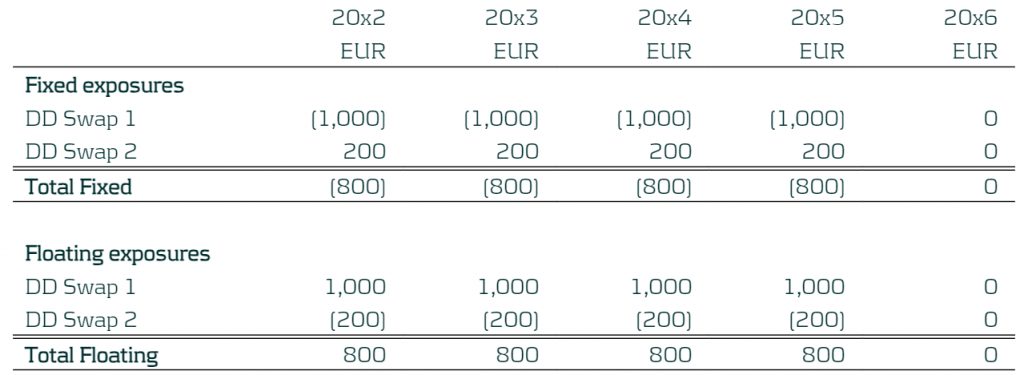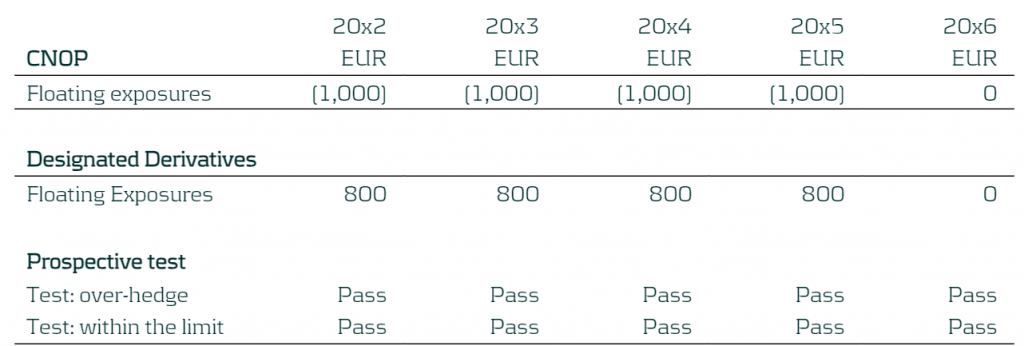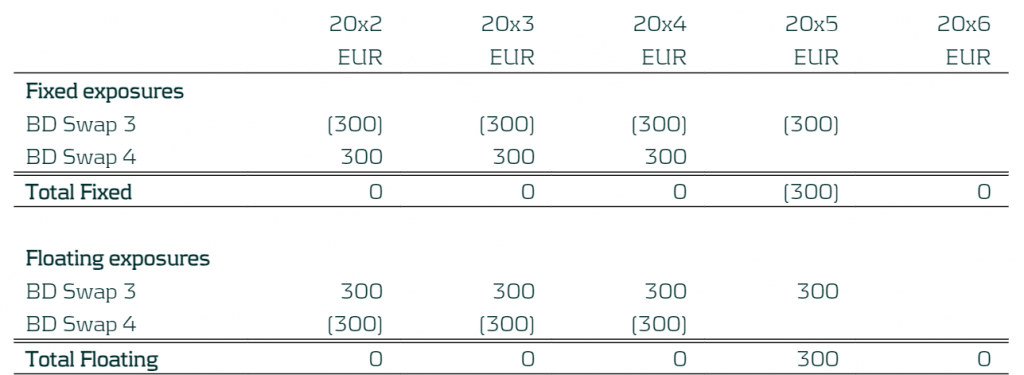The DRM Cycle: The Model in Action

Entities must consider numerous factors when transitioning to the new DRM model, it is crucial for entities to develop a clear implementation plan.
The final article from Zanders on the DRM model presents the lifecycle of the DRM model over a single hedge accounting period and the prospective and retrospective assessments that are required to be carried out to ensure that the entity is correctly mitigating its interest rate risk for the assets/liabilities designated for the Current Net Open Risk Position (CNOP). The cycle will be illustrated by Scenario 1C taken from Agenda Paper 4A – May 20231. This is a relatively simple example, more complex ones can be found within the staff paper.

Figure 1: DRM Cycle
Prospective (start of the hedge accounting period)
The first three steps are related to the prospective assessment in the DRM model cycle.
The use of the prospective assessment is to ensure that the model is being used to mitigate interest rate risk and achieve the target profile that is set out in the RMS. The RMS should include the following:
- The risk mitigation cannot create new risks
- The RMI has to transform the CNOP position to a residual risk position that sits within the target profile (TP)
Step 1: The entity decides on the securities to be hedged and calculates the net open risk position (from an outstanding notional perspective) per time bucket.
In the example below the company has floating and fixed exposures. The business in this case has a five-year fixed mortgage starting in 20x2 which is fully funded by a five-year floating rate liability. The focus period is 20x2 (start of the hedge accounting period) to 20x3 (end of the hedge accounting period) and so the first period 20x1 has been removed. The entity manages its entity-level interest rate risk for a 5-year time horizon, based on notional exposure in ∆NII and has decided to set the TP to be +/-EUR 500 in each of the repricing periods. Below we present the total fixed and total floating exposures from the product defined above). The individual breakdown of the fixed and floating is not required as each exposure is hedged as a total. The exposure are positions at year end.

Table 1: CNOP of the Entity with yearly buckets
Step 2: The entity will calculate the RMI based on the designated derivatives. The entity decided to mitigate 80% of the risk through the use of the following derivatives (existing and new). Please note that is a combination of derivatives from all the derivatives available in the books:
- A 5-year pay fixed receive floating IR swap with notional of EUR 1,000, traded on 1st January 20x1 (DD Swap 1) (existing deal).
- A 4-year receive fixed pay floating IR swap with notional of EUR 200, traded on 1st January 20x2 (DD Swap 2)
This leads to the designated derivatives with the following exposures:

Table: Exposures of the Designated Derivatives
The exposures of the designated derivatives can then be compared to the CNOP as shown below:

Table 2: Exposures of the CNOP and Designated Derivatives
As the entity manages its interest rate risk based on ∆NII, the RMI focuses on the floating exposure.
The prospective test is performed by comparing the CNOP and Designated Derivatives exposures at each time bucket to see whether this moves the residual risk inside the TP (+/- EUR 500) set out within the RMS and not providing an over-hedge position. In this case the residual risk will be 0 (80% of CNOP versus DD exposures) and so the prospective assessments pass for all the time buckets.

Table 3: Prospective test
Step 3: Benchmark derivatives (hypothetical derivatives) are constructed based on the RMI calculated above.

Table 4: Benchmark Derivatives created for the Fixed and Floating Exposures
Retrospective (end of the hedge accounting period)
The following steps are related to the retrospective assessment of the DRM model.
The IASB requires a retrospective assessment, to check that risks have been mitigated, as well as a future capacity assessment for each period2. This is to ensure the company is correctly mitigating its interest rate risk, ensuring the CNOP sits within their TP and to quantify the potential misalignment arising from unexpected changes (during the hedge accounting period).
Step 4: The entity updates the CNOP with the latest ALM information (note that new business is excluded from the updated CNOP).
In this example, the financial asset was repaid fully at the end of 20x5. The revised expectation is that it will be partially repaid per end 20x4 and the rest repaid end 20x5.

Table 5: Updated CNOP
Step 5: The potential misalignment due to unexpected changes is calculated. The new CNOP is compared to the RMI that was set in Step 2. Misalignments can occur due to:
- Difference in changes in the fair value of the designated derivatives and benchmark derivatives (i.e: different fixed rate, fair value adjustments)
- The effect of the unexpected changes in the current net open position during the period

Table 6: Updated CNOP

Table 7: Determining the effect of unexpected changes
If there are misalignments and the entity breaches the retrospective assessment, meaning that it has been over-mitigating its risk, the benchmark derivatives will need to be revised. One way in which this can be achieved is through the creation of additional benchmark derivatives which can represent the misalignment occurring. These will be based on the prevailing benchmark interest rates.
Therefore, for this example, the entity will construct two additional benchmark derivatives to represent these changes:
- A 4-year pay fixed rate receive floating IR swap with notional of EUR 300, maturing on the 31st December 20x5 (BD Swap 3)
- A 3-year receive fixed pay floating IR swap with notional of EUR 300, maturing on 31st December 20x4 (BD Swap 4)

Table 8: Additional Benchmark Derivatives
Step 6: The hedge accounting adjustments are calculated, and the DRM model outputs are required to be booked3:
- a) The designated derivatives to be measured at fair value in the statement of financial position.
- b) The DRM adjustments to be recognised in the statement of financial position, as the lower of (in absolute amounts):
- The cumulative gain or loss on the designated derivatives from the inception of the DRM model.
- The cumulative change in the fair value of the risk mitigation intention attributable to repricing risk from the inception of the DRM model. This would be calculated using the benchmark derivatives (from step 3 and step 5) as a proxy.
- c) The net gain or loss from the designated derivatives calculated in accordance with (a) and the DRM adjustment calculated in accordance with (b) would be recognised in the statement of profit or loss.
The table below presents the EUR booking figures for this example. Figures are for the period 20x2 to 20x3.
The underlying items block represents the interest rate paid/received for the financial asset and financial liability for the period.
The designated derivative block presents the fair value movement of the designated derivatives for the period and the realised cash flow (net interest rate paid or received) on these instruments (trading income).
The DRM adjustment block presents the fair value movement of the benchmark derivatives for the period and the realised cash flow on these instruments (trading income).
BS represents a balance sheet account when IS represents an income statement account.

Table 9: Booking figures

Table 10: Booking figures calculation
Step 7: The last step is the future capacity assessment which was introduced by the IASB in February 2023 and is still under development so the final implementation of this is still to be released. This step is used to replace the previous retrospective assessment that compared the CNOP sensitivity to the TP. The IASB have yet to release more information on the methodology. The example shown does not assume that the future capacity assessment is carried out.
What Next?
The IASB plans to publish an exposure draft by 2025 and so companies start thinking about their process for onboarding the DRM model in their accounting process. The DRM model introduces a range of changes to the hedge accounting framework and the transition process will not be an easy switch. Therefore, companies need to ensure that they have a clear and concise implementation plan to ensure a smooth transition. Involvement from stakeholders from across the company such as (IT, Front Office, Risk, Accounting, Treasury) is required to ensure the project is implemented correctly and in time.
What can Zanders offer?
Transitioning to the new DRM model can be difficult due to the dynamic nature of the model, especially with a more complex balance sheet. Zanders can provide a wide range of expertise to support in the onboarding of the DRM model into your company’s hedging and accounting. We have supported various clients with hedge accounting– including impact analyses, derivative pricing and model validation, and are familiar with the underlying challenges. Zanders can manage the whole project lifecycle from strategizing the implementation, alignment with key stakeholders and then helping design and implement the required models to successfully carry out the hedge accounting at every valuation period.
For further information, please contact Pierre Wernert, or Alexander Oldroyd.
Read our other blogs and learn more on Rethinking Macro Hedging: Introduction to DRM, and Rethinking Macro Hedging: What are the Key Components of the DRM Model?
- Agenda Paper 4A ↩︎
- The capacity, introduced in Staff Paper 4B – February 2023, assessment is still subject to further development. ↩︎
- Staff Paper 4A – May 2022 ↩︎
Rethinking Macro Hedging: What are the Key Components of the DRM Model?

The aim of the DRM model is to tie together hedge accounting with risk management strategy so that an entity’s effort to mitigate interest rate risk is better reflected within their financial statement.
In the second instalment of the Zanders series on the DRM model, the Risk Management Strategy (“RMS”) and the DRM process are introduced and with it the new concepts that the IASB have established. The RMS sets out how an entity will manage its interest rate risk, which is the basis of every other part of the DRM model. The IASB has laid out the following expectations for a company’s RMS1:
- Process to approve and amend RMS
- Risk management levels and scope of assets and liabilities
- Risk metrics used
- Range of acceptable risk limits (i.e. the target profile)
- Risk aggregation method and risk management time horizon
- Methodologies to estimate expected cash flows and/or core demand deposits.
Changes to the RMS that result in a change in the target profile (“TP”), lead to a discontinuation of the hedge2. The IASB will further deliberate on when the discontinuation occurs and whether such changes lead to discontinuation of the model at a future date3.
The overall aim of the model is to compare the target profile (“TP”) with the current net open positions (“CNOP”) and thereby produce a risk mitigation intention (“RMI”), which represents the amount of risk that the entity intends to mitigate through the use of designated derivatives. The IASB has tentatively decided that each separate currency should have its own DRM model.
Below a figure of the DRM process can be found that shows how the different components of the model relate to each other. In the following sections a detailed explanation will be provided for each of these elements.

Figure 1: DRM process
As part of the RMS the entity is required to define the target risk metric. The company cannot change this metric for each period and must stick to the metric specified within the RMS. However, the RMS can specify the use of a different metric over different future time horizons. E.g. the company’s RMS could be to stabilise NII for the first three years on notional exposure and then the present value using PV01 for the following years.
Current Net Open Position
The first step in implementing the model is to decide on the assets and liabilities that should be hedged through the DRM framework. The eligible assets and liabilities are currently:
- Financial assets or liabilities must be measured at amortised cost under IFRS 9
- Future transactions that result in financial assets or financial liabilities that are classified as subsequently measured at amortised cost under IFRS 9 ($4.2.1).
Furthermore, the IASB has imposed the following criteria on the eligible assets/liabilities that can be designated in the CNOP4, 5; an asset/liability is only eligible if all the criteria are met:
| No. | Eligibility criteria for the Assets/Liabilities as hedged items |
| 1 | The effect of credit risk does not dominate the changes in expected future cashflows. |
| 2 | Future transactions must be highly probable except in the case of transactions that are the reinvestment or refinancing of existing financial assets/liabilities6. |
| 3 | Items already designated in a hedge accounting relationship are not eligible. |
| 4 | Items must be managed on a portfolio basis for interest rate risk management purposes. |
Table 2: Criteria for Assets & Liabilities
An asset/liability is eligible for the CNOP if all the above criteria are met. The IASB has explored other eligible assets/liabilities and have concluded that assets/liabilities that are FVOCI7 are recommended to be eligible while the ones that are FVPL8 were not recommended to be eligible. Equity was deemed not to be eligible for designation in the CNOP. Since the DRM model is still under review, the eligible assets/liabilities could change before the draft is finalised. Therefore, we advise companies to stay up to date with the latest information.
Target Profile
The Target Profile (TP) is linked to a company’s RMS. It sets the risk limits on the CNOP, before risk mitigation actions can be initiated. When the company assesses the risk over different time buckets, it needs to be consistent with the company’s RMS. All of this should be clearly documented within the company’s RMS. The TP should be set at the time when the hedge relationship is designated. The company can also take action to mitigate risks even before the limits are breached. Stakeholders have raised concerns regarding the granularity for the TP. Therefore, the IASB will conduct further research in this area to identify a common principle to be used universally for the allocation of risk limits for the TP.9
Risk Mitigation Intention
The Risk Mitigation Intention (RMI) is a calculated metric based on the company's efforts, through the use of derivatives, to reduce its CNOP for each period to align with the TP outlined in the RMS. Once the RMI is set, it cannot be changed retrospectively. When an entity is deciding on its RMI the following should be considered10:
- The RMI cannot exceed the CNOP. When entities monitor their CNOP by time buckets, this must hold for any time bucket
- The RMI needs to transform the CNOP position to a residual risk position that sits within the TP
- The RMI needs to be evidenced by real actions taken such as the actual derivates traded in the market
Stakeholders have been concerned that they may not be able to faithfully mitigate the risk with market traded instruments due to liquidity. E.g. there may be little liquidity for a nine-year interest rate swap to hedge an asset that reprices in nine years in the CNOP. Therefore, the IASB has tentatively stated that an entity could use a 10-year swap for a 9-year hedge. Then in the model the RMI is set to be 0 for the 10th year and the benchmark derivative matures on the 9th year. Therefore, the misalignment due to the extra year for the designated derivative would be reported in the profit and loss11.
Designated Derivatives
Designated derivatives are the instruments that mitigate interest risk for the company. These are entered into with external counterparties. They are also used to evidence the RMI that a company is taking. The full list of designated derivatives has not been set, it is expected it will contain interest rate swaps (including basis swaps), forward starting swaps and forward rate agreements12. In Staff Paper 4C – July 2023, the AISB recommended that non-linear derivatives, except for net written options, are eligible as designated derivatives.
Benchmark Derivatives
Benchmark derivatives (BD) are based on the same concepts as IFRS 9’s hypothetical derivatives. These are used to measure the efficacy of the hedging. The benchmark derivatives are based on the following specified characteristics13:
- The benchmark derivative is constructed to be on-market at designation – i.e constructing a “hypothetical” derivative that is nil at zero, where the floating leg replicates the managed risk, and the fixed leg is calibrated to the yield curve. Note that benchmark derivatives are only constructed once and are therefore not reset at every period.
- A benchmark derivative cannot be used to include features in the value of the RMI that only exist in the designated derivative (but not the RMI) – This means that features from the designated derivative cannot be used in the benchmark derivative if they don’t exist in the RMI.
- The amount of risk and the tenor of the benchmark derivative is prescribed by the RMI and expressed in the risk metric (i.e. KPI) the entity manages at the repricing time period – E.g. if an company is using PV01 as the managed KPI, the amount of risk is measured as the sensitivity of one basis point shift in the managed yield curve.
Transitioning to the new DRM model can be difficult due to the dynamic nature of the model, especially with a more complex balance sheet. Zanders can provide a wide range of expertise to support in the onboarding of the DRM model into your company’s hedging and accounting. We have successfully supported various clients with hedge accounting– including impact analyses, derivative pricing and model validation, and are familiar with the underlying challenges. Zanders can manage the whole project lifecycle from strategizing the implementation, alignment with key stakeholders and then helping design and implement the required models to successfully carry out the hedge accounting at every valuation period. As the deadline is quickly approaching it would benefit entities to start assessing the key characteristics of the DRM model in order to understand how to change their current framework to the new one.
For further information, please contact Pierre Wernert, or Alexander Oldroyd.
Read our other blogs and learn more on Rethinking Macro Hedging: Introduction to DRM and The DRM Cycle: The Model in Action.
- IASB Webcast – October 2022 ↩︎
- Staff Paper 4A – November 2021 ↩︎
- Staff Paper 4A – April 2023 ↩︎
- Staff Paper 4B – April 2018 ↩︎
- Staff Paper 4A – February 2023 ↩︎
- Staff Paper 4C – April 2023 ↩︎
- Fair Value through Other Comprehensive Income ↩︎
- Fair Value through Profit or Loss. ↩︎
- Staff Paper AP4 – July 2022 ↩︎
- Staff Paper 4A – May 2022 ↩︎
- Staff Paper 4B – April 2023 ↩︎
- Staff Paper 4C – July 2023 ↩︎
- Staff Paper 4B – April 2023 ↩︎
Rethinking Macro Hedging: Introduction to DRM

First in a series of articles by Zanders introducing the Dynamic Risk Management model proposed by the IASB to revolutionize hedge accounting for dynamic portfolios
The current standards for hedge accounting present significant challenges for financial institutions engaged in dynamically hedging their portfolios. The corresponding type of hedging accounting, known as “macro fair value hedge accounting”, is covered under IAS 39; however, the regulations fall short as they are unable to accurately reflect an organization’s risk management strategies in its financial reporting. In some instances, companies cannot apply hedge accounting as their hedge is deemed to be ineligible unless they perform some form of proxy hedging strategies. To address these issues, the international Accounting Standards Board (“IASB”) have introduced the Dynamic Risk Management (“DRM”) approach, which is intended to offer a more effective method for entities to apply macro hedging.
The current timeline by the IASB is for a first draft to be released in 2025. This article forms the first in a series of three that will delve into the DRM model, explore its improvements over the current regulations and provide a demonstration of a practical implementation of the current proposal. The insights provided within this series, are Zanders’ understanding drawn from the discussion papers that the IASB has released and so the information is subject to change before the publication of the draft in 2025.
The IASB is aiming for the DRM model to allow readers of the financial statement to gain the following insights:
- The entity’s interest rate risk management strategy and how it is applied to manage interest rate risk.
- How the entity’s interest rate risk management activities may affect the amount, timing and uncertainty of future cash flows.
- The effect of the DRM model on the entity’s financial position and financial performance.
Within the May 2022 Staff Paper1, the IASB staff have identified a list of deficiencies of the current IAS 39 and IFRS 9 standards. The main limitations identified were:
| Number | Area | Description of limitation |
| 1 | Closed Portfolios | The current regulations are designed for “closed portfolios” and requires the direct linkage of hedged items with a hedge. This causes problems as currently an “open portfolio” would be viewed as a set of multiple “closed portfolios”, each with short periodic lifespans. This leads to challenges, as any “open portfolio” hedge relationships need to be tracked individually and its hedge adjustments amortized accordingly. |
| 2 | Risk Management on a net basis | Generally, entities will manage their exposures to interest rate risk on a net basis. However, currently hedges need to be managed on a gross basis. This means that interest rate risk management can be incorrectly represented to achieve the accounting requirements. |
| 3 | Dual character of net interest rate risk position | The repricing risk of the net interest rate risk position arises from a combination of variable and fixed-rate exposures. The economic mismatch has both fair value and cash flow variability when interest rates change, and entities try to mitigate both aspects economically. However, the current hedge accounting requirements state that the hedging relationship must be designated as either a fair value hedge with the fixed rate item or as a cash flow hedge with the variable item. |
| 4 | Demand deposits | Under the current regulations demand deposits cannot be hedged by banks as, from an accounting perspective, the fair value is constant. Since banks are unable to apply hedge accounting to demand deposits, they cannot accurately portray their risk management within the financial statements. |
The next two articles in this series will provide a comprehensive exploration of the DRM model and introduce the new concepts that the IASB has proposed. The next article offers a breakdown of the Risk Management Strategy (“RMS”) within the DRM model, how it factors into a company’s overarching strategy for managing their interest rate risk. It will cover the new concepts that the IASB have established. The third and final article in this series will provide an overview of the DRM cycle as well as an example taken from the IASB of how the DRM model would be applied in practice for a singular accounting period. Stay tuned!
What can Zanders offer?
Transitioning to the new DRM model can be difficult due to the dynamic nature of the model, especially with a more complex balance sheet. Zanders can provide a wide range of expertise to support in the onboarding of the DRM model into your company’s hedging and accounting. We have supported various clients with hedge accounting– including impact analyses, derivative pricing and model validation, and are familiar with the underlying challenges. Zanders can manage the whole project lifecycle from strategizing the implementation, alignment with key stakeholders and then helping design and implement the required models to successfully carry out the hedge accounting at every valuation period.
For further information, please contact Pierre Wernert, or Alexander Oldroyd.
Read our other blogs and learn more on The DRM Cycle: The Model in Action, and Rethinking Macro Hedging: What are the Key Components of the DRM Model?


